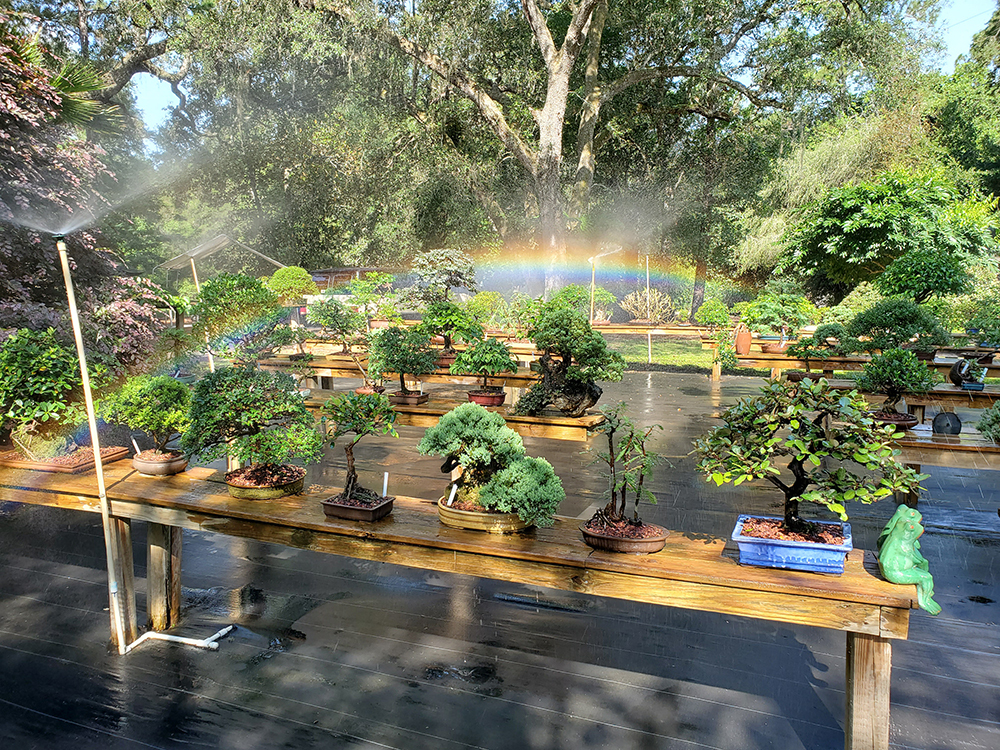
Watering is the most important aspect of Bonsai care. If you are like most people, and you don't have a green thumb, here are three simple rules you might find useful:
1. Don't let the soil become bone dry.
2. When you water, water thoroughly. Make sure the water soaks all of the soil.
3. Allow the soil to dry down to almost dry between waterings.
Check the soil for moisture daily. Don't just check the surface, but stick your finger into the soil and see if there is moisture beneath the surface. Then decide whether there is enough moisture to hold the tree until the next time you can check. Be aware of conditions like sun and humidity. If you think there isn't enough water in the soil to hold the tree until you can check again, go ahead and water. Otherwise wait.
Though there is much more to the art of watering, if you follow these simple instructions, you'll be off to a good start.
TOP WATERING
Though some books advocate soaking the pot in a tub of water, we don't recommend this technique. We prefer top watering.
Here's how you top water:
Use a watering can, hose with a nozzle, or any gentle stream of water. Water through the leaves into the soil. This mimics rain by washing the leaves. Do this for a few seconds, then wait a few seconds until the water has soaked into the soil. Repeat 3 or 4 times or until you are satisfied that all of the soil is well soaked.
Once the soil is soaked, wait until it is dry before watering again. If you don't let the soil dry down between waterings, at least most of the time, then you run the risk of causing root rot.
Conversely, if you wait too long between waterings and allow the soil to become bone dry, you run the risk of severely stressing your Bonsai (or worse).
Checking for moisture:
There are several ways to check the soil for moisture. Most people prefer sticking their finger a little way into the soil. This is the technique we use.
Another good technique, especially with deep pots, or when the soil is somewhat compacted, is to use a chopstick. Push the stick way down into the soil and then pull it out. Feel the stick and the soil that comes off onto the stick. If it is damp, wait to water. If it is dry, water now.
If the soil is only slightly damp (no matter how you check it) then you need to consider the risk of it drying out too much before you have a chance to check it again. If it is a hot dry day, and you are not sure, it is better to go ahead and water. One of the worst things that can happen to your Bonsai is for it to cook in the sun with no moisture in the soil.
When a Bonsai dies, more often than not, it is because of watering problems.
Persistent over watering will gradually kill your Bonsai. If you don't allow the soil to dry down between waterings, at least some of the time, then your Bonsai will develop root rot. This is a fungus that thrives in persistently wet soil, and is anathema to roots.
However, the biggest risk of all is drying out. All you have to do is forget to water it once. If the soil becomes bone dry, then your Bonsai will suffer. The longer it stays dry the more it will suffer. The risk is particularly high if the tree sits in the hot sun with dry soil.
What actually happens is the dry soil sucks the moisture out of fine white new feeder roots. After a while these delicate new roots lose their turgidity and collapse. When these fine roots collapse, they begin to disintegrate. When they disintegrate, they die. Without these fine feeder roots your Bonsai cannot absorb water, gasses and nutrients, and your tree stresses and begins to die.
So don't let the soil become bone dry. Especially on hot dry days. If you notice before there is any serious damage you can still save the tree.
After root pruning and potting, your tree has gone through a lot. First thoroughly water the pot to wash out any sediments and eliminate air pockets. Place your tree in a well lite but shaded area away from any wind. Some trees that have been severly root pruned go into a transplant shock and lose most or all of their leaves. It is very critical that after the first soaking you do not overwater.The tree has a limited amount, if any, foliage to transpire water, plus most of its roots have been removed. You should maintain a moderate moisture level. In 2-3 weeks as the tree starts to produce new leaves gradually acclimate it to more sun and increase the moisture as needed. Do not feed for at least a month. Super Thrive can be used in the initial watering.



